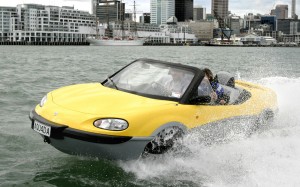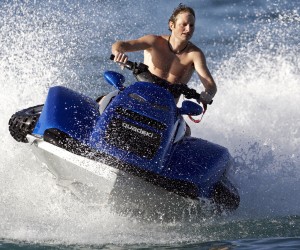
Gibbs Chairman Neil Jenkins, driving this Gibbs Aquada in New Zealand, says the company could begin producing the Aquada in as little as six months after it gains regulatory approval.
Automotive dreamers have coveted the notion of an amphibious car almost since the first autos started showing up on the world’s dusty streets.
Several have tried, most notably Hanns Trippel, who designed several amphibious vehicle, including the most well-known, the 1960s Amphicar.
But no one has developed what anyone could call a commercially successful production amphibious car.
So how does the planned production of an amphibious ATV bring that car one step closer to reality? Let’s take a look.

The production version of the Gibbs Quadski will finally break cover next month. The production version will be higher with larger fenders than this prototype version.
Gibbs Sports Amphibians announced that it would begin production of its Quadski amphibian next month in Auburn Hills, Mich. The Quadski is capable of 45 mph on land and in water and is able to transition between the two in as little as five seconds. The Quadski uses what Gibbs calls High Speed Amphibian technology, the key to which, is wheels that retract into the wheel wells to allow the vehicle to plane.
But that’s a single-seat, straddle-style ATV. Could Gibbs also design a car that could do what the Quadski does?
In a word, yes. In fact, Gibbs began development of its Aquada, a three-seat sports car that looks a bit like an oversized Mazda Miata, in 1997, before it began work on the Quadski. Gibbs expected the Aquada to go into production at least three years ago, but regulatory hurdles have stopped the company from producing it.
The Quadski could be the key to easing the regulatory problems for the Aquada, Gibbs Chairman Neil Jenkins told FastAmphibians.com.
It’s possible that once the world starts seeing the Quadski in action, enthusiasts may start asking about the car. And seeing the Quadski in action could also encourage U.S. regulators to allow Gibbs to start building and selling the Aquada here.
“(The Quadski) will take away some of the fears the regulatory agencies have,” Jenkins told TheDetroitBureau.com two years ago.
The problem is that current regulations on cars and boats conflict. Jenkins has said that the company would have to invent new technology to simultaneously meet some of the requirements of multiple agencies.
For example, Environmental Protection Agency emission requirements necessitate a catalyst, which needs to operate at hundreds of degrees hotter than the U.S. Coast Guard allows in the engine compartment of a boat. Gibbs has suggested an exhaust that would remove the catalyst from the exhaust while in the water, but EPA has rejected that approach.
Another problem: National Highway Traffic Safety Administration regulations require that all cars have airbags. But pounding waves would be enough to set off sensitive airbag sensors. One idea would be a switch that deactivates the airbag when in water, but NHTSA has rejected that approach.
Attorneys working with Gibbs on finding solutions to the regulatory hurdles have suggested that regulators should stop trying to shoehorn the Aquada into existing regulations for cars and boats and instead open a new classification for “amphibians.”
So, instead of focusing on building a street-legal car, Gibbs has turned its attention to off-road products including the Quadski, the Phibian, a 30-foot amphibian aimed at the first-responder market, and the Humdinga, a 21.5-foot amphibian designed to traverse the most difficult terrain.
Click here to read the story introducing the Phibian.
Click here to read the story introducing the Humdinga.
When the government finally green lights the Aquada, Jenkins told The Wall Street Journal that it could be ready to start building them in limited numbers in as little as six months.
But in the meantime, Gibbs will begin selling the Quadski and begin to recoup some of the more than$200 million invested in the company by founder Alan Gibbs.
Bryan Laviolette is founder and editor of FastAmphibians.com.
